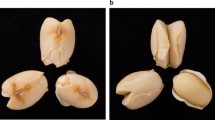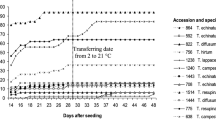Abstract
Cracking of seed coats in soybean (Glycine max (L.) Merr.) deteriorates the external appearance of seeds and reduces their commercial value. Two types of cracking have been reported that occur in some cultivars: Type I with irregular cracks and Type II with net-like cracks. This study was conducted to determine the genetic basis of net-like cracking. Genetic analysis was performed using F1 plants produced by crossing Uzuramame, a Japanese landrace with black seed coats having net-like cracking and a Clark mutant with black seed coats, their F2 population and F3 lines. Degree of cracking in individual plants was calculated by averaging cracking index (no cracking: 0 to severe cracking: 4) of total or 100-seed samples (average cracking index, ACI). Uzuramame exhibited intense cracking, whereas the Clark mutant showed slight cracking. Intermediate degree of cracking in F1 plants suggested incomplete dominance. ACI of F2 plants was continuously distributed. Gene number involved was estimated to be 1.4 by Wright's method. All F3 lines derived from F2 plants with ACI more than 2.8 displayed severe cracking phenotypes. In contrast, F3 lines derived from F2 plants with ACI less than 2.8 segregated from low to high ACI (0.5 to 3.2). When F2 plants were classified as slight (ACI<2.8) or severe (ACI>2.8) cracking, the frequency distribution of the F2 plants fitted to a 3:1 ratio. Genotypes of SSR marker Satt264 that is closely linked to SoyPRP1 locus for proline-rich cell wall protein had a minor effect on ACI. Further, seed weight was positively associated with ACI (r =0.46**). Our results suggest that net-like cracking is controlled primarily by a major gene, and SoyPRP1 and gene(s) contributing to seed weight may have minor effects on the intensity of cracking.
Similar content being viewed by others
References
Akkaya, M.S., A.A. Bhagwat & P.B. Cregan, 1992. Length polymorphisms of simple sequence repeat DNA in soybean. Genetics 132: 1131–1139.
Bernard, R.L., R.L. Nelson & C.R. Cremeens, 1991. USDA soybean genetic collection: isoline collection. Soybean Genet Newsl 18: 27–57.
Bradley, D.J., P. Kjellbom & C.J. Lamb, 1992. Elicitor-and woundinduced oxidative cross-linking of a proline-rich plant cell wall protein: a novel, rapid defense response. Cell 70: 21–30.
Cosgrove, D.J., 1993. How do plant cell walls extend? Plant Physiol 102: 1–6.
Cregan, P.B., T. Jarvic, A.L. Bush, R.C. Shoemaker, K.G. Lark, A.L. Kahler, N. Kaya, T.T. VanToai, D.G. Lohnes, J. Chung & J.E. Specht, 1999. An integrated genetic map of the soybean genome. Crop Sci 39: 1464–1490.
Datta, K., A. Schmidt & A. Marcus, 1989. Characterization of two soybean repetitive proline-rich proteins and a cognate cDNA from germinated axes. Plant Cell 1: 945–952.
Hong, J.C., R.T. Nagao & J.L. Key, 1987. Characterization and sequence analysis of a developmentally regulated putative cell wall protein gene isolated from soybean. J Biol Chem 262: 8367–8376.
Japanese Ministry of Agriculture, Forestry and Fisheries, 2001. Regulations on grade classification of agricultural products. Notification No. 244 of the Ministry of Agriculture, Forestry and Fisheries.
Kamiya, G. & T. Kiguchi, 1994. Rapid DNA isolation for RAPD analysis from soybean seed (in Japanese). Breed Sci 44 (Sup. 2): 121.
Lander, E.S. & D. Bostein, 1989. Mapping mendelian factors underlying quantitative traits using RFLP linkage maps. Genetics 121: 185–199.
Lander, E.S., P. Green, J. Abrahamson, A. Barlow, M.J. Day, S.E. Lincoln & L. Newberg, 1987. Mapmaker: an interactive computer package for constructing primary genetic linkage map of experimental and natural populations. Genomics 1: 174–181.
Liu, H.L., 1949. Inheritance of defective seed coat in soybeans. J Hered 40: 317–322.
McBlain B.A. & R.L. Bernard, 1987. A new gene affecting the time of flowering and maturity in soybean. J Hered 78: 160–162.
Nagai, I., 1926. [On the genetics of the soybean.] part 2 (in Japanese). Agriculture and Horticulture 1: 107–118.
Nicholas, C.D., J.T. Lindstrom & L.O. Vodkin, 1993. Variation of proline rich cell wall proteins in soybean lines with anthocyanin mutations. Plant Mol Biol 21: 145–156.
Palmer, R.G. & T.C. Kilen, 1987. Qualitative genetics and cytogenetics. In: J.R. Wilcox (Ed.), Soybeans: Improvement, Production, and Uses, 2nd edn. pp. 135-209. Agron Monogr 16. ASA, CSSA, and SSSA, Madison, USA.
Percy, J.D., R. Philip & L.O. Vodkin, 1999. A defective seed coat pattern (Net) is correlated with the post-transcriptional abundance of soluble proline-rich cell wall proteins. Plant Mol Biol 40: 603–613.
Showalter, A.M., 1993. Structure and function of plant cell wall proteins. Plant Cell 5: 9–23.
Stewart, R.T. & J.B. Wentz, 1930. A defective seed-coat character in soybeans. J Am Soc Agron 22: 658–662.
Sunada, K. & T. Ito, 1982. Soybean grain quality as affected by low temperature treatments in plants (color of hilum, seed coat cracking) (in Japanese). Rep Hokkaido Branch, Crop Sci Soc Jpn and Hokkaido Branch, Jpn Soc Breeding 22: 34.
Takahashi, R., 1997. Association of soybean genes I and T with low-temperature induced seed coat deterioration. Crop Sci 37: 1755–1759.
Takahashi, R. & J. Abe, 1994. Genetic and linkage analysis of low temperature-induced browning in soybean seed coats. J Hered 85: 447–450.
Takahashi, R. & J. Abe, 1999. Soybean maturity genes associated with seed coat pigmentation and cracking in response to low temperatures. Crop Sci 39: 1657–1662.
Takahashi, R. & S. Asanuma, 1996. Association of T gene with chilling tolerance in soybean. Crop Sci 36: 559–562.
Weiss, M.G., 1970. Genetic linkage in soybeans: Linkage group IV. Crop Sci 10: 368–370.
Wolf, W.J. & F.L. Baker, 1972. Scanning electron microscopy of soybeans. Cereal Sci Today 17: 125–130.
Wolf, W.J., F.L. Baker & R.L. Bernard, 1981. Soybean seed-coat structural features: Pits, deposits and cracks. Scann Electron Microsc 3: 531–544.
Woodworth, C.M. & L.F. Williams, 1938. Recent studies on the genetics of the soybean. J Am Soc Agron 30: 125–129.
Wright, S., 1934. The results of crosses between inbred strains of guinea pigs, differing in number of digits. Genetics 19: 537–551.
Yaklich, R.W. & G. Barla-Szabo, 1993. Seed coat cracking in soybean. Crop Sci 33: 1016–1019.
Yang, D., T. Nakamura, N. Ohtsubo, K. Takahashi, J. Abe & R. Takahashi, 2002. Seed coat cracking in soybean isolines for pubescence color and maturity. Crop Sci 42: 71–75.
Author information
Authors and Affiliations
Rights and permissions
About this article
Cite this article
Nakamura, T., Yang, D., Kalaiselvi, S. et al. Genetic analysis of net-like cracking in soybean seed coats. Euphytica 133, 179–184 (2003). https://doi.org/10.1023/A:1025541610329
Issue Date:
DOI: https://doi.org/10.1023/A:1025541610329




